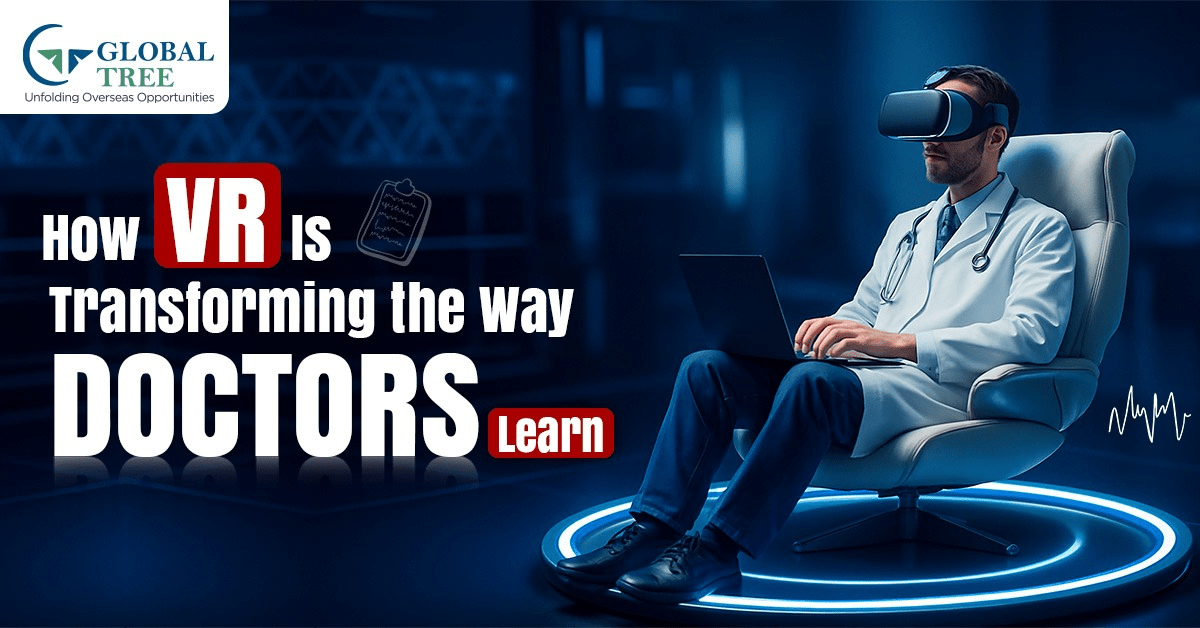Virtual Reality in Medical Education – Benefits, Use Cases & Future Trends

Introduction
Virtual Reality (VR) technology has had a significant impact on the field of medical education in recent years, transforming the way medical professionals are educated. With the capability to replicate complicated surgeries, structures of anatomical structures, and interactions with patients, VR provides a realistic and immersive educational experience that traditional education methods can't compare to. This blog explores the different ways that VR is being used in medical education, the benefits for educators and students, and the potential implications of this revolutionary technology for creating the future generation of medical professionals.
VR for Medical Education: The Essence
Virtual Reality (VR) is changing the way medical education is taught by providing an immersive, interactive, and safe educational environment. VR allows learners to experience the anatomy of their bodies, learn about procedures, and participate in simulated medical scenarios that are high-quality. VR helps improve understanding by allowing for experiential learning and enhances retention, permitting repeated practice with no risk of injury. VR ensures uniform education across different institutions and offers immediate feedback that helps improve abilities. In addition, VR supports collaborative learning by resembling team-based health care settings. The technology helps bridge the gap between theories and actual practice. It makes medical education more enjoyable, efficient, and accessible in the end, preparing learners better for the real-world issues.
Market Overview of VR for Medical Education
It is estimated that the VR medicine education industry is growing rapidly and is expected to grow to $1.5 billion in 2026. This is with an increase of more than 30 percent. Based on the need for safe, engaging, and accessible training, virtual Reality enhances the clinical capabilities without compromising the patient's safety. North America leads in adoption; however, Asia-Pacific is experiencing a significant expansion. Principal players include Osso VR, SimX, and VirtaMed. With the advancement of technology, particularly in AI and haptics, as demand grows in countries hiring Indian doctors, nurses & healthcare staff, VR will play a vital role in delivering standardized training and improving how professionals communicate with patients worldwide.
Use Cases of VR for Medical Education
1. Anatomy Learning
Imagine being inside the human body, literally. Through VR, medical students can investigate 3D anatomical structures at every angle, cut back muscles, look into organs, and observe systems moving. This is a lot more exciting than reading through textbooks or simply relying on cadavers. It's also repeatable and accessible anywhere, anytime. It helps students to comprehend spatial relations better and is essential in the transition from theoretical to real-world clinical applications. It's the equivalent of Google Maps specifically for the human body!
2. Surgical Training
The training of surgeons in VR is an exciting development. Instead of performing training with animals or waiting around for the elusive OR opportunities, students can step into the virtual operating room to practice realistic procedures over and over again. The trainees can experience hands-on playing with instruments, experience live feedback in real time, and can even experience pressure and resistance using tactile devices. It's secure, flexible, and perfect for developing confidence. This technology, which resembles a flight simulator, is made for those studying a surgery course study abroad and lets them practice surgeries repeatedly without real-world consequences.
3. Clinical Scenario Simulations
VR puts students into real-life scenarios in the clinic, from controlling cardiac arrests to handling emotionally distressed patients. This isn't just about the medical field, but also about making the right decisions in a stressful environment, collaboration, teamwork, and communication. The simulations replicate the stress and uncertainty of situations in the clinic and help students become at ease, prioritize tasks, and react quickly. The simulations can be repeated to get feedback and improve your strategy with no real-world implications. This is a highly effective method to get ready for what real life in the hospital is like.
4. Remote Collaboration & Learning
One of the best things about VR is that it allows for the connection of individuals. Medical students and professors from different countries or even cities get together in a virtual classroom and exchange 3D models, talk about scenarios, and work together. This is like a virtual classroom; however, it's more effective since you are able to interact with the objects around you and with the other participants in a shared area. This can be extremely beneficial in remote learning, continuous education, and collaboration across borders. There is no need to travel—just wear headphones and get in.
5. Patient Communication & Empathy Training
VR is a unique experience that puts you in the shoes of a patient. Imagine feeling what it is like as a person who has dementia or receiving a grave diagnosis. The VR scenarios assist medical students in comprehending the psychological and emotional aspects of the disease, while also helping them understand different types of psychological tests used in diagnosis.The focus isn't only on dealing with symptoms but rather connecting to people. When you develop empathy at an early age, students will become caring doctors and be better prepared to assist families and patients in difficult situations. It's uplifting, eye-opening, and memorable.
6. Procedural Rehearsal & Assessment
Before a complicated or unusual procedure, surgeons can practice their procedures in VR as athletes train before a huge event. If it's putting in an artery or performing laparoscopic surgery, VR can let them walk through each step of the procedure with no risk. Teachers can evaluate their skills objectively; no more uninformed grades. It helps ensure consistency and boosts confidence. Consider it an opportunity to practice for a high-stakes medication. If the time comes, they're prepared because they've accomplished it.
[Explore More: A Beautiful Future Awaits – Study Cosmetic Surgery Course Abroad]
Architecture of VR Medical Education Software
The architecture of VR medical education software typically combines multiple layers—hardware integration, 3D simulation engines, data processing, and user interaction modules—to deliver immersive and interactive training experiences. Here's a breakdown of its core components, explained in a structured and conversational way:
1. User Interface (UI) Layer
This is what the learner sees and interacts with—menus, dashboards, virtual environments, tools, and controls. It's designed to be intuitive so users can navigate VR simulations easily, whether they're choosing a surgical procedure to practice or reviewing feedback after a session.
2. Application Logic Layer
This is the brain of the system. It controls how the simulation behaves based on the user's actions. For example, if a student makes an incision incorrectly, the software might simulate bleeding or provide a prompt. It includes medical scenario logic, rules, and branching outcomes for various actions.
3. Simulation Engine
Powered by game engines like Unity or Unreal Engine, this component creates the 3D environment, animates anatomical models, and simulates physics (e.g., tissue resistance, tool movement). It ensures everything looks and behaves like it would in real life—crucial for realism and immersion.
4. Haptic & Device Integration Layer
This layer connects VR headsets (e.g., Meta Quest, HTC Vive), hand controllers, gloves, or surgical instruments. It translates physical actions (like grasping, cutting, or suturing) into digital inputs and may include haptic feedback systems to simulate touch and resistance.
5. Data & Analytics Layer
This backend system collects performance data—reaction times, errors, decision points—and generates analytics for both students and instructors. It supports progress tracking, skill assessments, and personalized learning paths.
6. Content Management System (CMS)
A backend module for educators to create, modify, and manage training scenarios. For instance, instructors can upload new procedures, adjust difficulty levels, or tailor assessments for different learners or specializations.
7. Cloud Infrastructure (Optional but Common)
Cloud-connected systems enhance scalability and remote access, allowing students to engage in VR modules from anywhere. This is particularly valuable for those who study in health and medicine, where real-time feedback and collaboration can simulate real-world clinical scenarios.
8. Security & Compliance Layer
To protect sensitive student and institutional data, especially in clinical scenarios, VR platforms must follow medical data regulations like HIPAA or GDPR, depending on the region.
Advanced Features of VR Medical Education Software
These are the top capabilities that take VR Medical Education software beyond simple simulations to the most cutting-edge technological training. Each of the features enhances real-world realism, involvement, or the educational value uniquely:
1. Haptic Feedback and Force Simulation
Advanced VR technology incorporates haptic instruments (gloves or tools for handheld use) that simulate contact pressure, pressure, and resistance. Users can experience what they're doing, such as cutting or suturing skin, adding an important tactile aspect to the experience of learning.
2. AI-Powered Adaptive Learning
With the help of Artificial Intelligence, training becomes both personalized and dynamic, making it easier to nurture creativity in students alongside academic progress. It adapts difficulty levels for each scenario, prompts intelligently, and suggests modules that are tailored to specific skill gaps. Imagine it as a tutor in virtual form that changes every time you use it.
3. Real-Time Performance Analytics
Advanced software can track metrics such as accuracy, precision, timing errors, and decision-making processes. Dashboards track progress, which allows both instructors and learners to see areas of strength and to improve. It also allows for objective evaluation and constant feedback.
4. Multi-User Collaboration & Role-Play
Instructors and learners can participate in the same virtual reality scenario in different locations. Teams can practice surgical procedures and emergency response, as well as the ward rounds, with every participant in their job (e.g., surgeon, nurse, or anesthetist) to improve the communication and teamwork skills of the team.
5. Voice Recognition and Natural Interaction
Certain systems let users converse in a natural way with virtual patients and team members by employing AI to recognize requests for voice and mimic real conversations. This increases immersion and can help develop empathy and communication skills.
6. Dynamic Scenario Branching
Patients' vitals could fluctuate in real time based on the actions of users. A missed diagnosis may result in a heart attack. This design of branching helps to teach the concept of cause and effect while encouraging the use of critical thinking as well as the ability to think critically.
7. Integration of EMR Simulations and EHR
Certain VR devices simulate medical records that allow the users to request tests, make notes, and then interpret laboratory outcomes as part of their user experience. The system integrates diagnostic and administrative activities into the learning loop.
8. Biofeedback and Stress Monitoring
The integration of sensors (e.g., eye tracker, heart rate) can allow the system to assess stress levels, response, and focus in the face of pressure. This is particularly helpful for situations with high stakes, such as trauma or code blue simulations.
9. Cross-Device and Cloud-Based Access
Modern platforms provide cross-platform support (desktop VR headsets, desktops, and AR glasses) and cloud-based access to scenarios, as well as synchronized progression across different devices. The learners can resume the place they left off at any time, from anywhere.
10. Regulatory Compliance & Credentialing Integration
For those aiming to practice abroad, these platforms are useful because they either meet regulatory standards or help in earning international certifications to build a career beyond borders. They can record hours, prove competencies, and also issue micro-credentials, digital badges, or digital certificates.
Conclusion
Virtual Reality is transforming medical education by making learning more immersive, hands-on, and accessible. As technology advances, with AI, haptics, and real-time collaboration, VR will become a core training tool, helping students practice safely, build confidence, and develop empathy. It bridges the gap between theory and real-world practice, shaping the next generation of skilled, prepared healthcare professionals. The future of medical education is not just digital; it's virtual.
Frequently Asked Questions
1. What is Virtual Reality in medical education?
Virtual Reality (VR) in medical education uses immersive 3D simulations to train students and professionals in anatomy, procedures, and clinical scenarios, providing realistic, hands-on learning without real-world risks.
2. How is VR used in medical training?
VR is used for surgical simulations, anatomy exploration, emergency response training, patient communication practice, and collaborative team scenarios. It allows learners to repeat procedures and receive real-time feedback.
3. What are the benefits of VR in medical education?
VR offers safe, repeatable practice, enhances spatial and procedural understanding, improves engagement, allows remote learning, and builds confidence without risking patient safety.
4. Is VR more effective than traditional medical training?
While not a full replacement, studies show VR can improve retention, performance, and skill acquisition, especially when combined with traditional methods like lectures and clinical rotations.
5. What equipment is needed for VR medical education?
Typically, a VR headset (e.g., Oculus Quest, HTC Vive), controllers or haptic devices, and compatible software are required. Some advanced setups may include gloves or surgical tool replicas.
6. Who can use VR for medical education?
VR is suitable for medical students, nursing trainees, residents, surgeons, and healthcare educators. It's also used by institutions, hospitals, and training centers for continuing education.
7. Are VR simulations realistic enough for real-life practice?
Modern VR simulations are highly realistic, often using real-world anatomical data and haptic feedback. While they don't replace real patients, they provide excellent preparation for real-life situations.
8. What are the limitations of VR in medical education?
Limitations include high setup costs, the need for technical support, occasional motion sickness, and limited availability of some highly specialized scenarios.
9. Can VR be used for assessment in medical education?
Yes, many VR platforms track performance metrics (accuracy, timing, and decision-making) and provide data-driven assessments, helping educators evaluate learner progress objectively.
10. What is the future of VR in medical education?
The future includes AI-driven adaptive learning, more realistic simulations with haptics and biofeedback, remote collaborative training, and integration with certification and electronic health systems.





